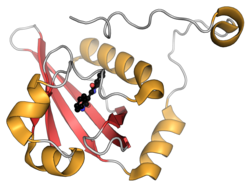芳香烴受體
芳香烴受體(英語:Aryl hydrocarbon receptor,或稱為芳烴受體或芳基烴受體,簡稱為AhR或AHR)是一種在人類中由 AHR 基因編碼的蛋白質。芳香烴受體是調節基因表現的轉錄因子。 它最初被認為主要作為異生化學物質的傳感器發揮作用,同時也作為代謝這些化學物質的細胞色素P450等酶的調節劑。 這些異生化學物質中最引人注目的是芳香族(芳基)烴,受體的名字也來源於此。
最近,已經發現AhR被許多內源性吲哚衍生物如犬尿胺酸活化(或失活)。 除了調節代謝酶外,AhR 還具有調節免疫、幹細胞維持、和細胞分化的作用[5][6][7]。
芳香烴受體是鹼性螺旋-環-螺旋轉錄因子家族中的一個成員。此受體的生理學配體未知,但它會結合多種外源性配體,例如天然植物黃酮類化合物、多酚類與吲哚類等,以及人造合成的多環芳烴以及二噁英樣物質化合物。AhR是一種通常情況下無活性而與一些共分子伴侶胞質溶膠結合的轉錄因子。一旦配體結合到例如2,3,7,8-四氯二苯二氧芑(TCDD)等化學物質上時,分子伴侶離解並導致AhR轉移到細胞核中並與ARNT(芳香烴受體核轉運體)二聚化,致使基因轉錄產生改變。
蛋白質功能域
編輯芳香烴受體(AhR)蛋白包含幾個對功能至關重要的結構域,被歸類為鹼性螺旋-環-螺旋/PAS結構域 (bHLH/PAS) 轉錄因子家族的成員[8][9]。bHLH基序位於蛋白質的N端,是多種轉錄因子中的一個共同實體[10]。bHLH 超家族的成員有兩個功能獨特且高度保守的結構域。 第一個是鹼性區 (b),它參與轉錄因子與 DNA 的結合。 第二個是螺旋-環-螺旋 (HLH) 區域,它促進蛋白質-蛋白質相互作用。
配體
編輯芳香烴受體(AhR)配體通常分為兩類,合成的或天然存在的。 第一個被發現的配體是合成的,包括鹵代芳烴(多氯雙苯並對二噁英、Polychlorinated dibenzofurans、和聯苯)和多環芳香烴(3-methylcholanthrene、苯並[a]芘、並四苯和β-萘黃酮)[11][12]。 一系列合成配體已被設計用於靶向未來可能的乳腺癌治療[13]。
研究集中在天然存在的化合物上,希望能識別出內源性配體。
參考文獻
編輯- ^ 1.0 1.1 1.2 GRCh38: Ensembl release 89: ENSG00000106546 - Ensembl, May 2017
- ^ 2.0 2.1 2.2 GRCm38: Ensembl release 89: ENSMUSG00000019256 - Ensembl, May 2017
- ^ Human PubMed Reference:. National Center for Biotechnology Information, U.S. National Library of Medicine.
- ^ Mouse PubMed Reference:. National Center for Biotechnology Information, U.S. National Library of Medicine.
- ^ Esser C. The Aryl Hydrocarbon Receptor in Immunity: Tools and Potential. Suppression and Regulation of Immune Responses. Methods in Molecular Biology 1371. 2016: 239–57. ISBN 978-1-4939-3138-5. PMID 26530806. doi:10.1007/978-1-4939-3139-2_16.
- ^ Kawajiri K, Fujii-Kuriyama Y. The aryl hydrocarbon receptor: a multifunctional chemical sensor for host defense and homeostatic maintenance. Experimental Animals. May 2017, 66 (2): 75–89. PMC 5411294 . PMID 27980293. doi:10.1538/expanim.16-0092.
- ^ Gutiérrez-Vázquez C, Quintana FJ. Regulation of the Immune Response by the Aryl Hydrocarbon Receptor. Immunity. January 2018, 48 (1): 19–33. PMC 5777317 . PMID 29343438. doi:10.1016/j.immuni.2017.12.012.
- ^ Burbach KM, Poland A, Bradfield CA. Cloning of the Ah-receptor cDNA reveals a distinctive ligand-activated transcription factor. Proceedings of the National Academy of Sciences of the United States of America. September 1992, 89 (17): 8185–9. Bibcode:1992PNAS...89.8185B. PMC 49882 . PMID 1325649. doi:10.1073/pnas.89.17.8185 .
- ^ Fukunaga BN, Probst MR, Reisz-Porszasz S, Hankinson O. Identification of functional domains of the aryl hydrocarbon receptor. The Journal of Biological Chemistry. December 1995, 270 (49): 29270–8. PMID 7493958. doi:10.1074/jbc.270.49.29270 .
- ^ Jones S. An overview of the basic helix-loop-helix proteins. Genome Biology. 2004, 5 (6): 226. PMC 463060 . PMID 15186484. doi:10.1186/gb-2004-5-6-226.
- ^ Denison MS, Pandini A, Nagy SR, Baldwin EP, Bonati L. Ligand binding and activation of the Ah receptor. Chemico-Biological Interactions (Submitted manuscript). September 2002, 141 (1–2): 3–24 [2023-04-27]. PMID 12213382. S2CID 29379967. doi:10.1016/S0009-2797(02)00063-7. (原始內容存檔於2023-05-05).
- ^ Denison MS, Nagy SR. Activation of the aryl hydrocarbon receptor by structurally diverse exogenous and endogenous chemicals. Annual Review of Pharmacology and Toxicology. 2003, 43: 309–34. PMID 12540743. doi:10.1146/annurev.pharmtox.43.100901.135828.
- ^ Baker JR, Sakoff JA, McCluskey A. The aryl hydrocarbon receptor (AhR) as a breast cancer drug target. Medicinal Research Reviews. May 2020, 40 (3): 972–1001. PMID 31721255. doi:10.1002/med.21645 .




